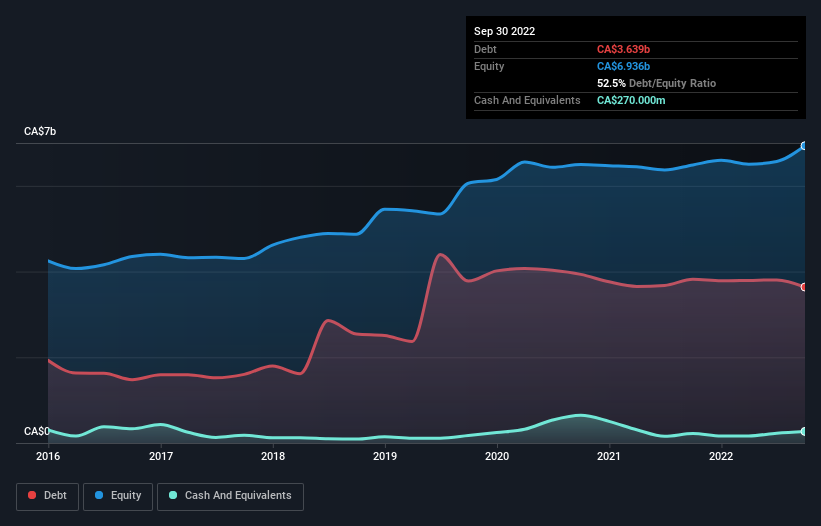Warren Buffett famously said, 'Volatility is far from synonymous with risk.' So it seems the smart money knows that debt - which is usually involved in bankruptcies - is a very important factor, when you assess how risky a company is. Importantly, Saputo Inc. (TSE:SAP) does carry debt. But is this debt a concern to shareholders?
Why Does Debt Bring Risk?
Debt assists a business until the business has trouble paying it off, either with new capital or with free cash flow. Part and parcel of capitalism is the process of 'creative destruction' where failed businesses are mercilessly liquidated by their bankers. However, a more common (but still painful) scenario is that it has to raise new equity capital at a low price, thus permanently diluting shareholders. Of course, plenty of companies use debt to fund growth, without any negative consequences. The first thing to do when considering how much debt a business uses is to look at its cash and debt together.
View our latest analysis for Saputo
How Much Debt Does Saputo Carry?
You can click the graphic below for the historical numbers, but it shows that Saputo had CA$3.64b of debt in September 2022, down from CA$3.82b, one year before. However, because it has a cash reserve of CA$270.0m, its net debt is less, at about CA$3.37b.

A Look At Saputo's Liabilities
Zooming in on the latest balance sheet data, we can see that Saputo had liabilities of CA$2.91b due within 12 months and liabilities of CA$4.32b due beyond that. On the other hand, it had cash of CA$270.0m and CA$1.67b worth of receivables due within a year. So its liabilities total CA$5.29b more than the combination of its cash and short-term receivables.
While this might seem like a lot, it is not so bad since Saputo has a huge market capitalization of CA$14.0b, and so it could probably strengthen its balance sheet by raising capital if it needed to. But it's clear that we should definitely closely examine whether it can manage its debt without dilution.
We measure a company's debt load relative to its earnings power by looking at its net debt divided by its earnings before interest, tax, depreciation, and amortization (EBITDA) and by calculating how easily its earnings before interest and tax (EBIT) cover its interest expense (interest cover). Thus we consider debt relative to earnings both with and without depreciation and amortization expenses.
Saputo has net debt to EBITDA of 2.9 suggesting it uses a fair bit of leverage to boost returns. On the plus side, its EBIT was 8.2 times its interest expense, and its net debt to EBITDA, was quite high, at 2.9. Sadly, Saputo's EBIT actually dropped 8.1% in the last year. If that earnings trend continues then its debt load will grow heavy like the heart of a polar bear watching its sole cub. When analysing debt levels, the balance sheet is the obvious place to start. But ultimately the future profitability of the business will decide if Saputo can strengthen its balance sheet over time. So if you want to see what the professionals think, you might find this free report on analyst profit forecasts to be interesting.
But our final consideration is also important, because a company cannot pay debt with paper profits; it needs cold hard cash. So the logical step is to look at the proportion of that EBIT that is matched by actual free cash flow. Over the most recent three years, Saputo recorded free cash flow worth 58% of its EBIT, which is around normal, given free cash flow excludes interest and tax. This free cash flow puts the company in a good position to pay down debt, when appropriate.
Our View
Even if we have reservations about how easily Saputo is capable of (not) growing its EBIT, its interest cover and conversion of EBIT to free cash flow make us think feel relatively unconcerned. Looking at all the angles mentioned above, it does seem to us that Saputo is a somewhat risky investment as a result of its debt. Not all risk is bad, as it can boost share price returns if it pays off, but this debt risk is worth keeping in mind. The balance sheet is clearly the area to focus on when you are analysing debt. However, not all investment risk resides within the balance sheet - far from it. For example, we've discovered 2 warning signs for Saputo that you should be aware of before investing here.
At the end of the day, it's often better to focus on companies that are free from net debt. You can access our special list of such companies (all with a track record of profit growth). It's free.
New: Manage All Your Stock Portfolios in One Place
We've created the ultimate portfolio companion for stock investors, and it's free.
• Connect an unlimited number of Portfolios and see your total in one currency
• Be alerted to new Warning Signs or Risks via email or mobile
• Track the Fair Value of your stocks
Have feedback on this article? Concerned about the content? Get in touch with us directly. Alternatively, email editorial-team (at) simplywallst.com.
This article by Simply Wall St is general in nature. We provide commentary based on historical data and analyst forecasts only using an unbiased methodology and our articles are not intended to be financial advice. It does not constitute a recommendation to buy or sell any stock, and does not take account of your objectives, or your financial situation. We aim to bring you long-term focused analysis driven by fundamental data. Note that our analysis may not factor in the latest price-sensitive company announcements or qualitative material. Simply Wall St has no position in any stocks mentioned.
About TSX:SAP
Saputo
Produces, markets, and distributes dairy products in Canada, the United States, Australia, Argentina, and the United Kingdom.
Excellent balance sheet average dividend payer.
Similar Companies
Market Insights
Community Narratives



